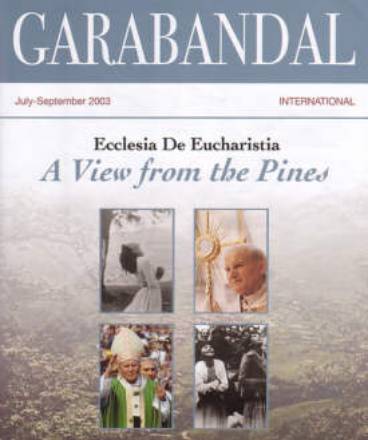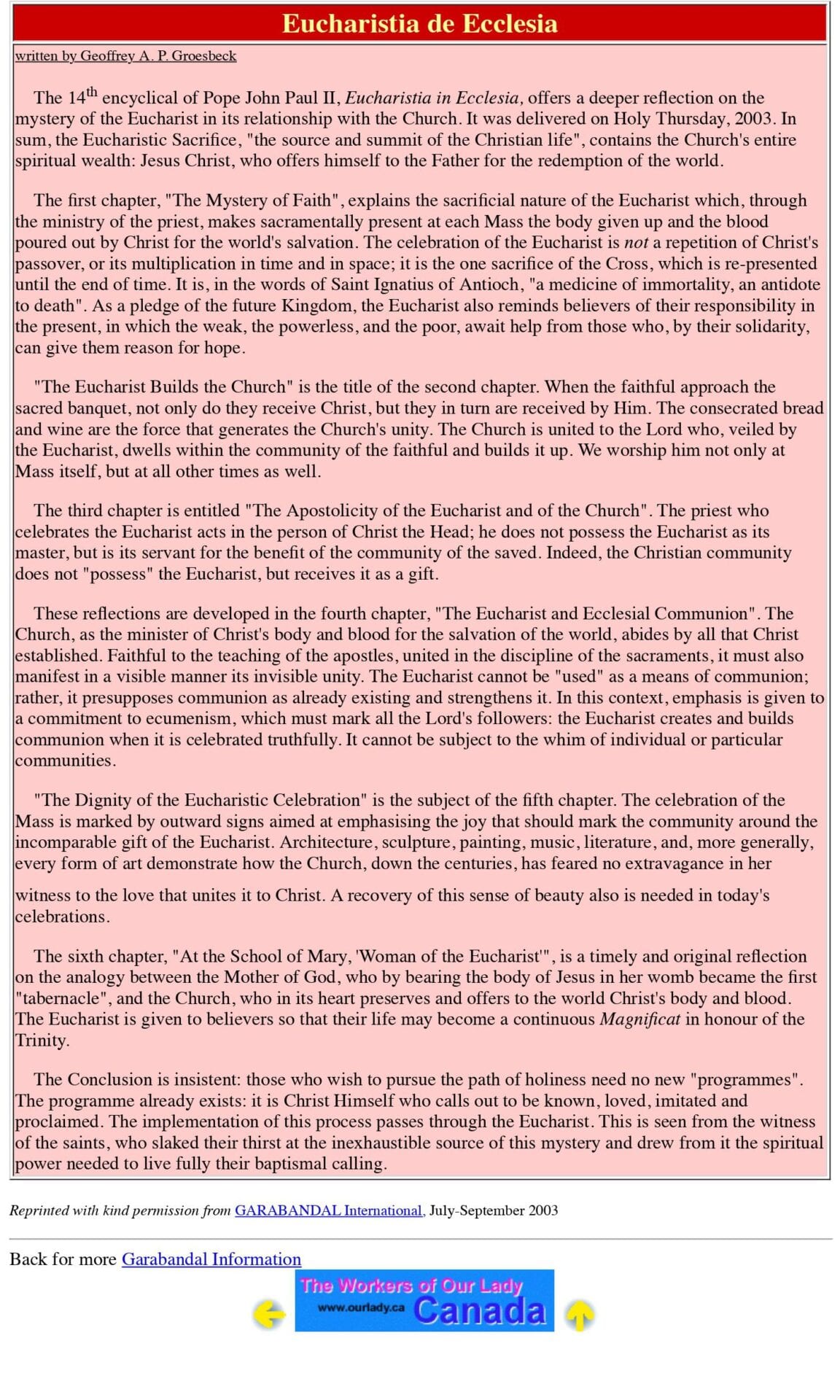Ecclesia De Eucharistia: A View from the Pines (Gabriel Garnica)
COVER STORY July 2003
Ecclesia De Eucharistia: A View from The Pines
Reprinted with kind permission from GARABANDAL International, July-September 2003
written by Gabriel Garnica

In his most recent document, Pope John Paul II tackles an issue that has become as controversial as it is central to the Catholic faith: The Eucharist.
As in his other recent writings on the Rosary, the Holy Father serves as a beacon of light in a world increasingly clouded by confusion, distortion, and compromise. Equally important, however, is the strong inclusion of the Blessed Virgin Mary in John Paul’s eucharistic writings, and his elegant and profound advocacy for her role in true eucharistic adoration. To the Garabandal follower, this connection between the Eucharist and our Blessed Mother rings a familiar, and pleasant, tune.
The numerous points made in Ecclesia De Eucharistia can be grouped into five general themes, all relevant to the Garabandal message and events. Likewise, the last of these general themes, relating to the importance of Mary in eucharistic relevance and adoration, can itself be presented in five points, all relevant and critically tied to the Garabandal events and message.
Five General Themes
One of the central themes of the Pope’s document is the idea that the Eucharist is both the life blood and the mortar of the Church, constantly revitalizing and building it. It is not simply some daily faith expression or fraternal banquet, but a “constant fulfillment of the promise that Christ will be with us always.” The Eucharist is a sacrificial and sacramental gift of Christ of Himself to us. We recall that at Garabandal the Virgin Mary told the children that it was a greater grace to receive Jesus in Holy Communion than to see Her! Also, given a choice between a locution and a Communion, the children unhestitatingly chose Communion. Finally, we should recall that the first miracle at Garabandal, that of the visible Host, was of a eucharistic nature. How reverently and lovingly the children came to see Communion at the instruction of our Mother! Alas, how disrespectfully and disgracefully many treat the Eucharist today. From laughing on the way to receiving it, to treating the Host as some sort of “cookie”, many today have lost the sense of how important and relevant the Eucharist really is in the life of the Church and the faithful.
Another theme of the Pope’s document, most important in our faith yet under seige in modernist trends, is the concept of the Real Presence of Christ within the Eucharist. John Paul II reminds us that Christ is wholly and entirely present in the Eucharist. Unlike those who view Communion as a symbolic reminder of the Last Supper, Catholics believe the Eucharist is the reception of Christ Himself. This is one reason why the Pope is concerned with allowing ecumenical efforts to overshadow and replace basic Catholic cornerstones regarding the Eucharist. Included in these concerns is the highly publicized warning that non-Catholics should not receive Communion in a Catholic Church. As noted above, our Blessed Mother clearly reminded us of the Real Presence by her words and actions at Garabandal.
A third theme regarding the Eucharist expressed in Ecclesia De Eucharistia runs consistent with the theme of eucharistic respect and reverence. John Paul II reminds us that we must first confess our sins before receiving Communion, as outlined in the teachings of the Council of Trent. The Pope notes that while our state of grace is a private matter based on a self-examination of conscience, any outward conduct while living in a state of public sin calls for direct Church involvement. An example of this would be receiving Communion while living with someone outside of marriage, or after marrying outside the Church without a valid annulment to a previous Church marriage. We recall that at Garabandal the Virgin did not kiss a wedding ring belonging to someone in a false matrimonial state, and that the children often knew while in locution those in such states. The angry and arrogant outcries of people in such situations “demanding” to be allowed to receive Communion is a clear example of a society where personal idolatry, freedom, and disrespect seeks to overturn God Himself.
The Pope also stresses the theme that the sacrificial and sacramental nature of the mystery of the Eucharist does not allow for reduction or exploitation. It must be “expressed and lived in its integrity both in its celebration and prayerful meditation afterward”. The message of June 18,1965 stated: “Less and less importance is being given to the Eucharist.” We thus see that Pope John Paul’s Ecclesia De Eucharistia is a reminder of many of the concerns present at Garabandal.
The final general theme, and the springboard to our discussion of Mary’s role in all of this, is the Pope’s clear message that she has a central and critical role in eucharistic devotion. Nowhere is this more evident than at Garabandal, where the Virgin brought us a message steeped in Eucharistic reverence and adoration. Let us briefly tie together five points eloquently made by our Pope, all relative to Garabandal.
Mary was the first “tabernacle” in history in which the Son of God allowed Himself to be adored (by Elizabeth). Did not our Blessed Mother appear at Garabandal holding her Divine Son both physically in her arms and profoundly in her words and example?
The Eucharist, as a reminder of Calvary, is therefore a reminder of the giving to us of Mary as our spiritual mother. In one beautiful yet concise expression, the Pope begins the bridge between our Blessed Mother and the Eucharist. How powerfully the Garabandal message drives home the notion of Mary as our heavenly mother! Are not the Garabandal accounts filled with stories of motherly love, concern, and even playfulness?
Mary is present with the Church and as the Mother of the Church at each of our celebrations of the Eucharist. If the Church and the Eucharist are inseparable, so are Mary and the Eucharist. It is impossible to think of the visible Host and the Eucharis-tic elements of the Garabandal message without thinking of her who appeared there!
Mary’s Magnificat represents the true eucharistic attitude of praising God through, in, and with Jesus. Just as Mary’s life was shown in this utterance, so the Eucharist is given us so that we can try to make our own selves offer a Magnificat as well. Does not the Garabandal message, taken as a whole, demonstrate a model of praising God in word and action? Did not the Blessed Virgin carry this message and example to us?
In Mary we also see the mystery, transforming power, renewal, and love of the Eucharist. She is our guide and teacher in the true adoration and respect of the Eucharist. Does not our Blessed Mother represent and show us all of these things? Did not Garabandal become a Marian lesson in such adoration, respect, and application of eucharistic power?
In conclusion, our spiritual guide here on earth, Pope John Paul II, has once again blessed us with a profound and relevant document to nourish our efforts to live as Christ taught us to live. In this document, he reminds us that the Eucharist is central to the life and action of the Church. This treasure from heaven transforms humble bread and wine into the food we need for our own journey. It also reminds us of Calvary, the mystery of salvation, and of the role of our Blessed Mother as our guide and example in living a life along the lines of her Magnificat.
We must never allow this treasure to be tarnished by the conventions of an increasingly disrespectful, forgetful, and arrogant world. Both the events and message of Garabandal and Ecclesia De Eucharistia remind us that, through the most holy Eucharist, Christ walks beside us on our own road to Emmaus, where we will come to know Him “through the breaking of the bread”.
* * *


